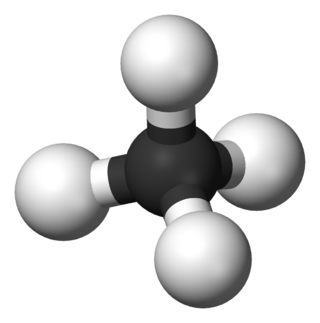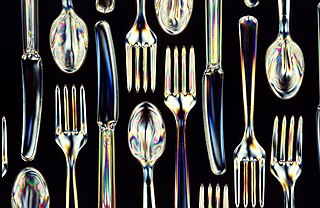
Biopolymers are natural polymers produced by the cells of living organisms. Like other polymers, biopolymers consist of monomeric units that are covalently bonded in chains to form larger molecules. There are three main classes of biopolymers, classified according to the monomers used and the structure of the biopolymer formed: polynucleotides, polypeptides, and polysaccharides. The Polynucleotides, RNA and DNA, are long polymers of nucleotides. Polypeptides include proteins and shorter polymers of amino acids; some major examples include collagen, actin, and fibrin. Polysaccharides are linear or branched chains of sugar carbohydrates; examples include starch, cellulose, and alginate. Other examples of biopolymers include natural rubbers, suberin and lignin, cutin and cutan, melanin, and polyhydroxyalkanoates (PHAs).

In organic chemistry, a hydrocarbon is an organic compound consisting entirely of hydrogen and carbon. Hydrocarbons are examples of group 14 hydrides. Hydrocarbons are generally colourless and hydrophobic; their odor is usually faint, and may be similar to that of gasoline or lighter fluid. They occur in a diverse range of molecular structures and phases: they can be gases, liquids, low melting solids or polymers.

Waxes are a diverse class of organic compounds that are lipophilic, malleable solids near ambient temperatures. They include higher alkanes and lipids, typically with melting points above about 40 °C (104 °F), melting to give low viscosity liquids. Waxes are insoluble in water but soluble in nonpolar organic solvents such as hexane, benzene and chloroform. Natural waxes of different types are produced by plants and animals and occur in petroleum.

Taphonomy is the study of how organisms decay and become fossilized or preserved in the paleontological record. The term taphonomy was introduced to paleontology in 1940 by Soviet scientist Ivan Efremov to describe the study of the transition of remains, parts, or products of organisms from the biosphere to the lithosphere.

Suberin is a lipophilic, complex polyester biopolymer of plants, composed of long-chain fatty acids called suberin acids and glycerol. Suberin, interconnected with cutins and lignins, also complex macromolecules, form a protective barrier in the epidermal and peridermal cell walls of higher plants. Suberins and lignins are considered covalently linked to lipids and carbohydrates, respectively, and lignin is covalently linked to suberin, and to a lesser extent, to cutin. Suberin is a major constituent of cork, and is named after the cork oak, Quercus suber. Its main function is as a barrier to movement of water and solutes.

Sporopollenin is a biological polymer found as a major component of the tough outer (exine) walls of plant spores and pollen grains. It is chemically very stable and is usually well preserved in soils and sediments. The exine layer is often intricately sculptured in species-specific patterns, allowing material recovered from lake sediments to provide useful information to palynologists about plant and fungal populations in the past. Sporopollenin has found uses in the field of paleoclimatology as well. Sporopollenin is also found in the cell walls of several taxa of green alga, including Phycopeltis and Chlorella.
Cutin is one of two waxy polymers that are the main components of the plant cuticle, which covers all aerial surfaces of plants, the other being cutan. It is an insoluble substance with waterproof quality. Cutin also harbors cuticular waxes, which assist in cuticle structure. Cutan, the other major cuticle polymer, is much more readily preserved in fossil records. Cutin consists of omega hydroxy acids and their derivatives, which are interlinked via ester bonds, forming a polyester polymer of indeterminate size.

Bioplastics are plastic materials produced from renewable biomass sources, such as vegetable fats and oils, corn starch and rice starch, straw, woodchips, sawdust, recycled food waste, etc. Some bioplastics are obtained by processing directly from natural biopolymers including polysaccharides and proteins, while others are chemically synthesized from sugar derivatives and lipids from either plants or animals, or biologically generated by fermentation of sugars or lipids. In contrast, common plastics, such as fossil-fuel plastics are derived from petroleum or natural gas.
Derek Ernest Gilmor Briggs is an Irish palaeontologist and taphonomist based at Yale University. Briggs is one of three palaeontologists, along with Harry Blackmore Whittington and Simon Conway Morris, who were key in the reinterpretation of the fossils of the Burgess Shale. He is the Yale University G. Evelyn Hutchinson Professor of Geology and Geophysics, Curator of Invertebrate Paleontology at Yale's Peabody Museum of Natural History, and former Director of the Peabody Museum.

Polyester is a category of polymers that contain one or two ester linkages in every repeat unit of their main chain. As a specific material, it most commonly refers to a type called polyethylene terephthalate (PET). Polyesters include naturally occurring chemicals, such as in plants and insects, as well as synthetics such as polybutyrate. Natural polyesters and a few synthetic ones are biodegradable, but most synthetic polyesters are not. Synthetic polyesters are used extensively in clothing.
Epicuticular wax is a waxy coating which covers the outer surface of the plant cuticle in land plants. It may form a whitish film or bloom on leaves, fruits and other plant organs. Chemically, it consists of hydrophobic organic compounds, mainly straight-chain aliphatic hydrocarbons with or without a variety of substituted functional groups. The main functions of the epicuticular wax are to decrease surface wetting and moisture loss. Other functions include reflection of ultraviolet light, assisting in the formation of an ultra-hydrophobic and self-cleaning surface and acting as an anti-climb surface.

A plant cuticle is a protecting film covering the outermost skin layer (epidermis) of leaves, young shoots and other aerial plant organs that have no periderm. The film consists of lipid and hydrocarbon polymers infused with wax, and is synthesized exclusively by the epidermal cells.

The enzyme cutinase is a member of the hydrolase family. It catalyzes the following reaction:
The Burgess Shale of British Columbia is famous for its exceptional preservation of mid-Cambrian organisms. Around 69 other sites have been discovered of a similar age, with soft tissues preserved in a similar, though not identical, fashion. Additional sites with a similar form of preservation are known from the Ediacaran and Ordovician periods.
A cuticle, or cuticula, is any of a variety of tough but flexible, non-mineral outer coverings of an organism, or parts of an organism, that provide protection. Various types of "cuticle" are non-homologous, differing in their origin, structure, function, and chemical composition.
Algaenan is the resistant biopolymer in the cell walls of unrelated groups of green algae, and facilitates their preservation in the fossil record.
Omega hydroxy acids are a class of naturally occurring straight-chain aliphatic organic acids n carbon atoms long with a carboxyl group at position 1, and a hydroxyl at terminal position n where n > 3. They are a subclass of hydroxycarboxylic acids. The C16 and C18 omega hydroxy acids 16-hydroxy palmitic acid and 18-hydroxy stearic acid are key monomers of cutin in the plant cuticle. The polymer cutin is formed by interesterification of omega hydroxy acids and derivatives of them that are substituted in mid-chain, such as 10,16-dihydroxy palmitic acid. Only the epidermal cells of plants synthesize cutin.
Dinosporin is a macromolecular, highly resistant organic compound which forms or partly forms, the enclosing wall of fossilizable organic-walled dinoflagellate cysts.
Most fossils represent mineralized material such as bone or shells. However, biopolymers such as chitin and collagen can sometimes leave fossils – most famously in Burgess Shale type preservation and palynomorphs. The preservation of soft tissue is not as rare as sometimes thought.

Cuticle analysis, also known as fossil cuticle analysis and cuticular analysis, is an archaeobotanical method that uses plant cuticles to reconstruct the vegetation of past grassy environments. Cuticles comprise the protective layer of the skin, or epidermis, of leaves and blades of grass. They are made of cutin, a resilient substance that can preserve the shapes of underlying cells, a quality that aids in the identification of plants that are otherwise no longer visible in the archaeological record. This can inform archaeobotanists on the floral makeup of a past environment, even when surviving remains from the plants are limited. Plant cuticles have also been incorporated into other areas of archaeobotanical research based on their susceptibility to environmental factors such as pCO2 levels and stresses such as water deficit and sodium chloride exposure. Such research can help to reconstruct past environments and identify ecological events.











